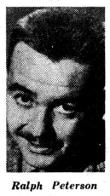Reuniting script-writer Gordon Chater and Ralph Peterson (who had previously successfully worked together on the highly successful sit-com My Name's McGooley - What's Yours?), Snake Gully with Dad and Dave was a modernised and updated version of Steele Rudd's popular characters--albeit a version that, as Don Storey notes in his Classic Australian Television, was based more on the 1930s' radio version than on the original novels.
Just as the radio version had updated the setting to a contemporary 1930s, Peterson's television scripts updated the setting again to the early 1970s, moving Dad and Dave further away from the late nineteenth-century selector culture of Rudd's original narratives. In this version, then, Dad and Dave are farmers on a small, struggling farm.
Despite these alterations, Storey notes that 'ATN-7 held high hopes for the series. The same combination of Ralph Peterson and Gordon Chater that worked on the McGooley series, couple with well-known and liked traditional Australian characters should have guaranteed success.'
It did not. The series was poorly received by both critics and viewers. Storey concludes that 'Budget limitations notwithstanding, the fact remains that a major shortcoming of the series was that the characters did not work well in a modern setting. It can be argued that if the traditional setting could not have been maintained, then the series should not have been made at all.'

 5021361077365553119.jpg
5021361077365553119.jpg